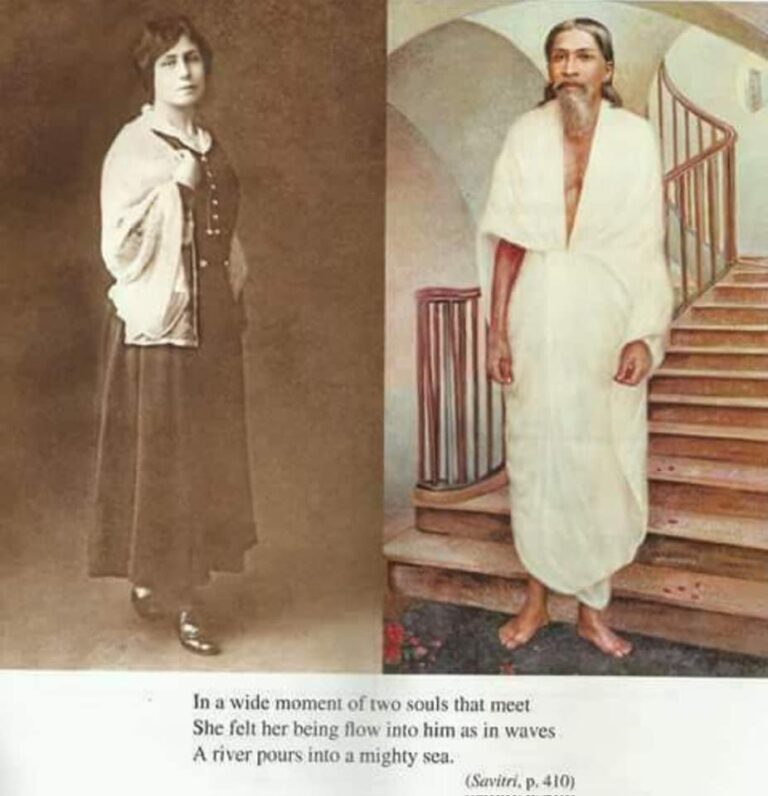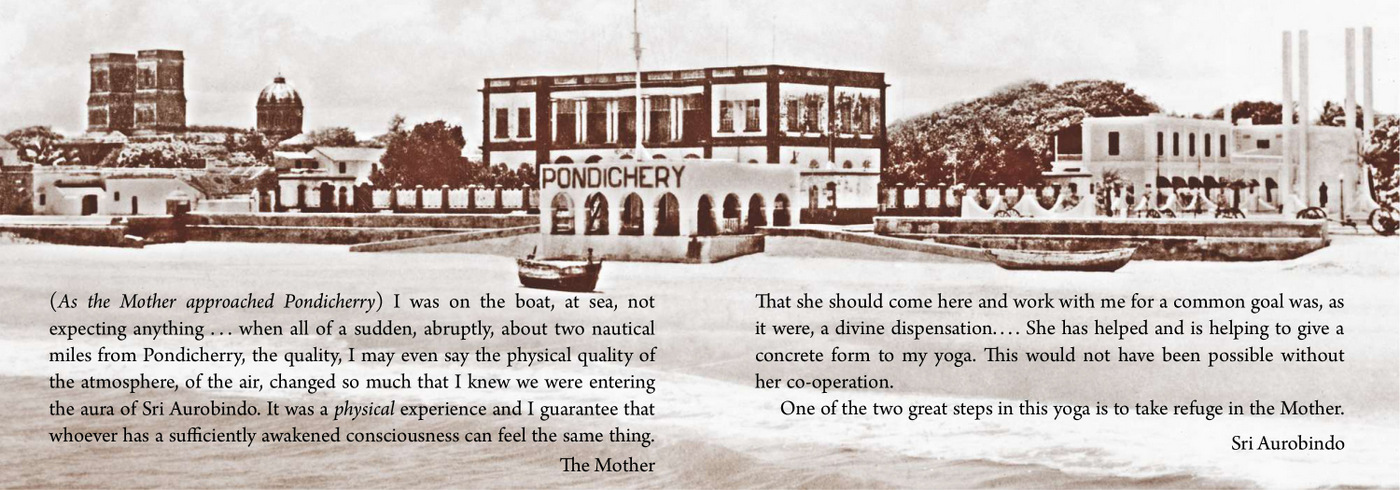The Mother
Mirra Alfassa
“What the soul sees and has experienced, that it knows; the rest is appearance, prejudice and opinion.”


The central circle represents the Divine Consciousness.
The four petals represent the four powers of The Mother.
The twelve petals represent the twelve powers of the Mother manifested for Her work.
– The Mother
What the World Knows
The Mother, born Mirra Alfassa, the spiritual collaborator of Sri Aurobindo, an Indian philosopher, yogi, artist and a poet. She was born on February 21, 1878, in Paris, France. Her mother was Mathilde Ismalun from Egypt and a Turkish father named Moïse Maurice Alfassa.
She showed an interest in spirituality and mysticism from a very young age and began to study various spiritual practices, including Hinduism, Buddhism, and Christianity. In 1914, she traveled to Pondicherry, India, to meet Sri Aurobindo, whom she recognized as her spiritual mentor.
Birth and Childhood
Mirra Alfassa (1878 – 1973) was born on 21st February 1878 in Paris as the second child of an Egyptian mother and a Turkish father. She began having mystical encounters as a young child, which opened her eyes to the possibilities of creating a New Consciousness that would unite spiritual and material life.
Sri Aurobindo later referred to this New Consciousness as the Supramental Consciousness. She experienced many mystical experiences beginning when she was four years old. She later recalled her early years by stating, “There was a small chair for me on which I used to sit still, engrossed in meditation. A very brilliant light would then descend over my head and produce some turmoil inside my brain”.
Education
She started attending a private school in 1887 to receive her formal education. She became fascinated with learning through both reading books and observing nature. She finished reading all of her father’s book collection by the age of fourteen. She developed an interest in a variety of extracurricular activities, such as tennis, singing, and sketching, in addition to her academic pursuits.
During this time, she began to have a number of psychic encounters that led her to believe in both the existence of God and the possibility of unity with Him. After graduating from high school in 1893, Mirra took a trip to Italy and experienced a flashback to her earlier years. She then pursued her passion for Art at Académie Julian and graduated in 1897.
For her interest in occultism, she travelled to Tlemcen, Algeria, in 1905 and 1906 to study with the adept Max Théon and Alma Théon, founders of the Cosmic Movement. However, her primary area of interest was spiritual growth. She founded a group called l’Idée Nouvelle for spiritual seekers in Paris and gave talks to various groups.

On 30th March, 1914 – the day after The Mother first met Sri Aurobindo – She wrote in Her diary:
…”It matters little that there are thousands of beings plunged in the densest ignorance, He whom we saw yesterday is on earth; his presence is enough to prove that a day will come when darkness shall be transformed into light, and Thy reign shall be indeed established upon earth.”…
The Mother First meeting with Sri Aurobindo
Mirra Alfassa’s first meeting with Sri Aurobindo is described in her own words in a recorded conversation from November 24, 1967:
“I saw Sri Aurobindo for the first time in 1914. At that time, I was staying in a small town in the Pyrenees, and one night, while I was asleep, I had a very strong experience, an experience of being in contact with something divine. The next day, I received a letter from a friend in Paris, telling me that she had met a great yogi and spiritual teacher in India, and that he had been sending out his force throughout the world, and that many people had been having experiences like mine.
“I immediately felt that this was the person I had been in contact with, and I decided to go to India to meet him. I arrived in Pondicherry in 1914 and went to see Sri Aurobindo. I had never seen him before, but as soon as I entered the room, I knew that he was the one I had come to meet. We talked for a while, and then I left, but from that moment on, I knew that my life was linked with his, and I knew that I would come back to stay with him.”
The Mother had to leave Pondicherry in 1915 as the First World War heated up, travelling first to France and later to Japan.
The Mother's final arrival to Pondicherry
Sri Aurobindo Ashram
On November 24, 1926, Sri Aurobindo achieved the siddhi of the overmind. Sri Aurobindo Ashram began taking shape as the Master began to refer to her as “The Mother” and entrusted the full responsibility of the ashram administration to the Mother.
On Sri Aurobindo’s own words
“There was no Ashram at first, only a few people came to live near Sri Aurobindo and practise Yoga. It was only some time after the Mother came from Japan that it took the form of the Ashram, more from the wish of the Sadhaks who desired to entrust their whole inner and outer life to the Mother than from any intention or plan of hers or of Sri Aurobindo.”

Sri Aurobindo International Centre of Education

Establishing Auroville


Supramental manifestation
Supramental manifestation refers to the realization of the supramental consciousness on Earth, which was one of the key goals of Sri Aurobindo’s and The Mother’s spiritual teachings. The supramental consciousness is a higher consciousness beyond the mental and vital levels of existence, characterized by unity, harmony, and spiritual evolution.
According to The Mother, the supramental manifestation involves the transformation of the entire being, from the physical to the spiritual, into a new and higher consciousness. This transformation is not limited to a few individuals but is a collective and evolutionary process that affects all of humanity and the entire Earth.
The Mother described the supramental manifestation as a gradual and progressive process that would unfold over time, with different stages and levels of development. She saw her own work as a preparation for the supramental manifestation and worked tirelessly towards its realization.
The first signs of the supramental manifestation were said to have occurred on February 29, 1956, when The Mother experienced a descent of the supramental consciousness into her own being. This event is known as the “Supramental Descent,” and it marked the beginning of a new phase in the spiritual evolution of humanity.
The Mother continued to work towards the supramental manifestation until her passing in 1973. She believed that the transformation of the Earth into a supramental consciousness was a process that would take time and required the active participation of individuals in their own spiritual evolution.
Mahasamadhi
In the words of Nirodbaran :
“On 17th November 1973, the Mother left her body. She was ninety-five. Many among her children were deeply shaken for the time being. But they realise now that she is always present amidst them.
Both at home and abroad, the devotees see the Mother in their dreams. They feel her presence, listen to her message and get inspiration and instruction in their work. They firmly believe that the Mother will return in a new form. Meanwhile her mission is getting quietly fulfilled more and more. When Sri Aurobindo left his body the Mother said, ‘Nothing has changed. All that Sri Aurobindo has said is true, time will prove it.’
On the Mother’s withdrawal, her children are carrying on her work repeating the same dictum – ‘Nothing has changed.’
It is upon you, the young, that her hope rests.”
– Nirodbaran, Sri Aurobindayan
The Mother’s last journey from the Meditation Hall to the Samadhi vault was published in the 1973 Ashram journal as follows.


“A casket was made of one-inch-thick rosewood and the inside was lined with a pure silver sheet and over this was a lining of felt and then white silk satin. On the lid of the casket was fixed a symbol of the Mother in pure gold.
At 8.00 a.m. on the 20th November, the Mother’s body was laid in the casket, which was then covered and sealed hermetically.
The casket was carried to the Samadhi and lowered into the chamber just above the vault in which Sri Aurobindo’s body had been laid in 1950. Nolini and André scattered some rose petals over the casket and concrete slabs were placed to cover the chamber. There was then a meditation for about ten minutes.
A running commentary on the event was given by All India Radio. After the meditation, wreaths and bouquets of flowers were laid on the Samadhi by the Government of Pondicherry, the French Consul and others…”



